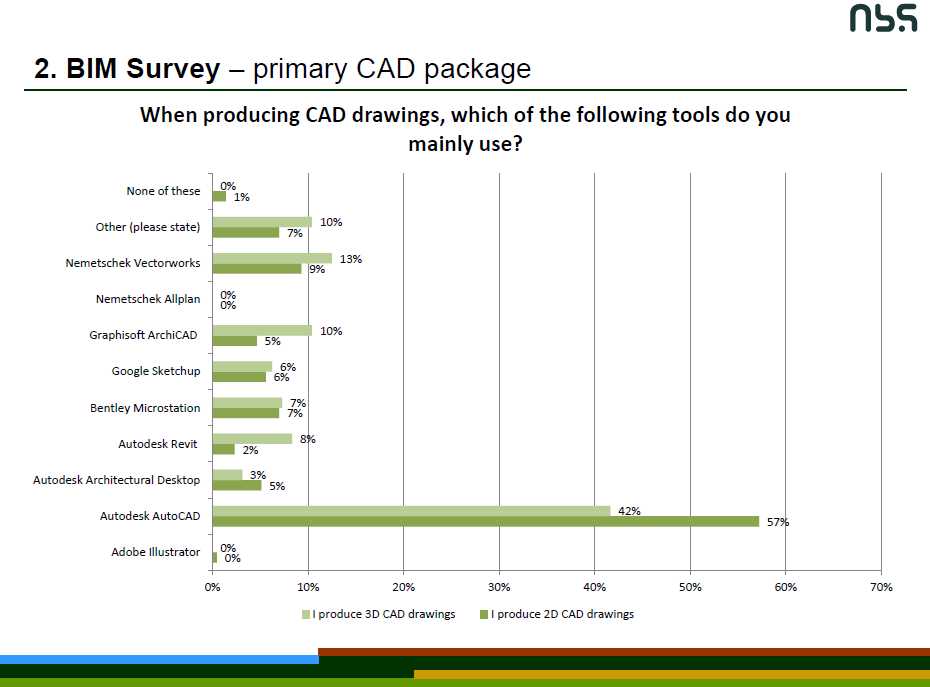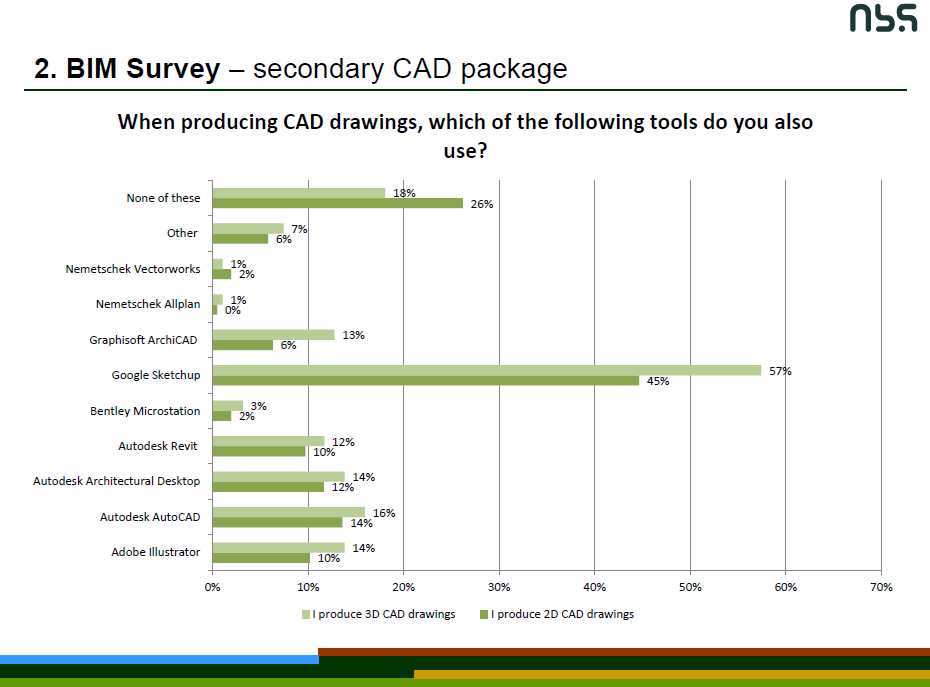Archive for category Adoption
BIM and Small Biz Survey Through Texas A&M
Posted by Jim Foster in Adoption, BIM on February 8, 2011
No new news here just spreading the word.
*******Original Post from the NIBS (National Institute of Building Sciences) Below *******
The Texas A&M University College of Architecture is seeking industry input. The college is surveying the industry to find out how the transition to building information modeling (BIM) is impacting small architectural firms. The survey is a key part of the data collection and is completely anonymous. The investigation has three central goals: to identify the current state of BIM adoption in architectural firms, to analyze the small firm BIM adoption process, and to develop a strategic model for small firm BIM adoption. Take the survey.
Sustainable BIM : AS Built BIM : DC Event : January 27th
Posted by Jim Foster in Adoption, BIM on January 21, 2011
Just saw this, and if you are in the area or inclined to travel looks like a good one and the price seems right. I included the details from the evite which you can also find here to register.
Topics & Speakers
BIM 101/State of the Industry
BIM As-built Concept & Downstream Uses
Residential BIM : Where you at?
Posted by Jim Foster in Adoption, BIM on January 20, 2011
 Recently we have delivered some large existing projects in Revit for various firms including an athletic center and large adaptive use use mill project, in fact, a lot of our commercial deliverables have been in BIM or more specifically Revit (don’t hate on me Archicad people just giving the market what it wants), however, it is rare indeed the residential project that is asking for Revit/BIM as a deliverable. Is this because the contractor/sub-contractor network is not there to leverage the benefits, or producing CDs and doing details/drafting is not seen as worth it? Are people using SketchUp in the concept phase and then going back to 2D drafting to produce drawings?
Recently we have delivered some large existing projects in Revit for various firms including an athletic center and large adaptive use use mill project, in fact, a lot of our commercial deliverables have been in BIM or more specifically Revit (don’t hate on me Archicad people just giving the market what it wants), however, it is rare indeed the residential project that is asking for Revit/BIM as a deliverable. Is this because the contractor/sub-contractor network is not there to leverage the benefits, or producing CDs and doing details/drafting is not seen as worth it? Are people using SketchUp in the concept phase and then going back to 2D drafting to produce drawings?
What’s your story? This is a call out for people’s workflow, experience, best practices, let’s best understand this market. Come on and share people.
UK Survey Projects 50% Increase in BIM usage in 2011 : + BIM UK Marketshare
Posted by Jim Foster in Adoption, BIM, Installed Base, Installed Seats on December 8, 2010
“The majority of the market is far from ready, but accepts the inevitability of a BIM future.” This on the “Conclusions” slide of Dr. Stephen Hamil, Head of BIM for NBS (National Building Standards), presentation. While the study as pointed out by Anna Winston on BD Online
(The) survey launched by standards and specifications expert NBS has revealed an ‘alarming lack of awareness’ of BIM across the construction industry.
The survey of 386 construction professionals, including 155 architects,showed that 43% were either unaware of or hadn’t used Building Information Modeling (BIM)
So mostly we are dealing with 57% of the total, however, more importantly from those respondents, 31% of those used BIM to a degree, but within the next year that figure doubled to 62% and within 3 years a whopping 82% expected to be working with BIM. And don’t tell me that 43% that did not know about BIM stays static. Especially, not when Paul Morell Chief Government Construction Advisor has already stated that he plans to bring BIM into the public procurement process.
Looks like a big BIM BOOM, and if so, let’s look at who is using which BIM authoring package which was also broken down by the NBS Survey.
You’ll see that Vectorworks at 13% and Archicad at 10% take up almost 1/4 of the market. Revit is at 8% and its second cousin ADT is at 3% (did they not get the memo its now ACA or Autocad Architecture.) However, more telling is SketchUP at 6% and AutoCAD at 42%. This is all for producing 3D drawings. I would think that Autodesk will push the bundling of AutoCAD and Revit hard in order to further their penetration. However, look at the chart below and you see that as a secondary package 57% are using SketchUp. Yoinks. Maybe just because its free, or its excelling at visual communication but it would seem to me that Google can leverage that position to get users on the Professional Version, or perhaps something else? But understand that it was included in the BIM conversation.
Global BIM in Abu Dhabi : Solving the same problems
Posted by Jim Foster in Adoption, Autodesk, BIM, IPD on December 6, 2010
 Reading a recent article in Construction Week I found it remarkable, but perhaps not surprising that the construction industry there is using the same analogies and facing the same issues we here in the US. Within a week Gerhard Hope of Construction Week posted two articles one titled, ‘MEP Contractors Still Wary of BIM‘ and ‘Design, Build, and Maintain‘ which promotes the use of BIM to solve construction, regulatory and maintenance issues. The jist of the first article is that the MEP contractors were giving up on BIM because generally it’s a lot of work. However, there were some great quotes.
Reading a recent article in Construction Week I found it remarkable, but perhaps not surprising that the construction industry there is using the same analogies and facing the same issues we here in the US. Within a week Gerhard Hope of Construction Week posted two articles one titled, ‘MEP Contractors Still Wary of BIM‘ and ‘Design, Build, and Maintain‘ which promotes the use of BIM to solve construction, regulatory and maintenance issues. The jist of the first article is that the MEP contractors were giving up on BIM because generally it’s a lot of work. However, there were some great quotes.
It means you do all the thinking and engineering before anyone starts building the structure or installing services. It has the big advantage of being able to plan ahead, and not find a major issue on the third floor, for example, that is going to stop work for a couple of months while somebody works out what to do.
One of the things about construction is that it is really a team activity, involving thousands of people on infrastructure projects, for example. A major change that has come about is the need for all professionals to work much closer together. I think BIM is certainly one of the ways that this can happen. We embraced BIM several years ago, in fact, on the Dubai Metro project, and we carried that forward on our metro work in Makkah and Calcutta, using the same methodology.
David Crowder – Atkins MEP Head of Department – Middle East and India
If you have a fast-track project with a lot of problems to fix, ultimately it all comes back to the quality of the documentation you started out with…BIM is a major advantage to the main contractor, because they are not fiddling around hacking out the structure, or changing the finishes, or lowering ceilings – all the things we know and love in the construction industry. Instead we generate all the drawings fully coordinated in the BIM environment
Steven Anderson – Atkins: Design Systems Manager – Middle East and India
Companies who are able to respond positively to these changes are the ones who are going to survive through these difficult times, as opposed to the dinosaurs, those companies which can only operate in a traditional business model. This will lead to a healthier marketplace and an industry as a whole.
Kevin Mitchell – Buro Happold : Director
And with Abu Dhabi still on the scene it was reported that Tekla ‘Shapes Abu Dhabi’s Pairs Sorbonne University‘ Also Tekla and Autodesk had announced last month a ‘collaboration to enable better BIM workflow‘ This announcement though sounds like two kids in the principals office who agree not to fight on the playground anymore. Obviously Autodesk want people to use Revit Structure, and anecdotally I hear most people say they use Tekla when going from design to fabrication, so what that collaboration will look like is anyone’ s guess, but the market must have been calling for something but what it’s mostly calling for is integration.
 People are frustrated. Frustrated that construction seems inefficient. With Technology that does not talk to each other. With doing the same thing 15 times because of the myriad of design / documentation packages out there do not talk to each other. That more problems are not figured out digitally instead of physically in the field where it costs infinitely more. The people want to use the best tool for the job and have that data act freely and unencumbered with other tools. However, with BIM (Building Information Models) we are a lot closer then we used to be and its a global phenomena.
People are frustrated. Frustrated that construction seems inefficient. With Technology that does not talk to each other. With doing the same thing 15 times because of the myriad of design / documentation packages out there do not talk to each other. That more problems are not figured out digitally instead of physically in the field where it costs infinitely more. The people want to use the best tool for the job and have that data act freely and unencumbered with other tools. However, with BIM (Building Information Models) we are a lot closer then we used to be and its a global phenomena.
When I say BIM what do you think? The US Army Corp of Engineers thinks Revit
Posted by Jim Foster in Adoption, Autodesk, BIM, Revit on December 2, 2010
While I am no shill, I just pasted this straight from the wire. Info you can use? Maybe/Maybe not, but if your trying get on schedule with the US Government for projects, I’d say knowing Revit is better than not knowing it, and here’s another data point why.
USACE Selects Autodesk Software Solutions for Mission Critical Applications
LAS VEGAS, Nov 29, 2010 (BUSINESS WIRE) — Autodesk University:
Autodesk, Inc. /quotes/comstock/15*!adsk/quotes/nls/adsk (ADSK 36.53, +1.24, +3.51%) , a world leader in 3D design, engineering and entertainment software, today announced that the U.S. Army Corps of Engineers (USACE), has signed a multi-flex, enterprise license agreement for Autodesk products and Autodesk-related services and training. The contract value of the deal is $6 million over a three year period and includes access to the following Autodesk products: the Autodesk Revit family of products; AutoCAD Civil 3D software; and Autodesk Navisworks software products, among others.
“We are extremely pleased to further strengthen our long-standing relationship with the USACE with this agreement,” said Bill Goodson, vice president, North American public sector and utility sales, at Autodesk. “Autodesk software plays a vital role in helping USACE provide quality and responsive engineering services to over 37,000 employees in 90 countries worldwide. This agreement ensures USACE will have full access to the latest innovative Building Information Modeling (BIM) software tools and professional services to support its national defense mission. The flexible and concurrent licensing Autodesk is offering the USACE will provide better asset management and version control.”
Autodesk Software Products: Mission Critical Solutions for USACE
As BIM-based designs are required by the General Services Administration (GSA), the USACE now requires a BIM-based design approach for all vertical military construction (MILCON) projects in fiscal year 2010 and beyond. With today’s announcement, the USACE will now have complete access to Autodesk’s BIM family of products, including Autodesk Revit Architecture software and Navisworks software products. By having access to the BIM products, USACE personnel — who deal with managing building construction, operations and maintenance — will have the software tools and training necessary to take better advantage of the 3D building models being delivered by design contractors.
Exchange BIM : Bid and Win : Autodesk giving it away : Adword model coming to BIM?
Posted by Jim Foster in Adoption, BIM, Marketing on December 1, 2010
 Okay so this might be premature but read today under Autodesk Broadens its Reach in the Wall Street Journal about how Autodesk is creating and marketing consumer products, where it currently holds no cache. Mention Autodesk to people outside of the AEC industry and they look at you much like a dog who’s heard a high pitch whistle. Autodesk created Sketchbook for the ipad and iphone. They also released Homestyler, which is free. The most expensive version of Sketchbook goes for $7.99. Now if you are not selling stuff to make money, how else can you do it? Let’s look at the popular models – you are a lead generation tool, allow advertising or create a marketplace and you take the vig on the transaction. If I am one, if not the biggest purveyor of 2D CAD and 3D Modeling Software I have an opportunity, an opportunity to hook into software that was not available when it was just 2D lines, but 3D objects, let’s think about it. One of the D’s, ‘Cost’, how is that driven through the system, well, mostly by quantity take offs, and creating a liquid marketplace that allows the quantity take offs, or actual fabrication to be bid on creates transparency/liquidity. Allowing for brand name components to be swapped into a building model, making it more of a building information model, allows it to be spec’d during the design phase, what’s that worth as a vendor? Even Microsoft is getting in on this with their release of Microsoft Hohm, energy data based on location, tax, records, etc. When looking at specific retrofits there is a frame with ‘local professionals.’ Cannot be long until they are offering branded insulation, (owens corning) , and Energy Star appliances.
Okay so this might be premature but read today under Autodesk Broadens its Reach in the Wall Street Journal about how Autodesk is creating and marketing consumer products, where it currently holds no cache. Mention Autodesk to people outside of the AEC industry and they look at you much like a dog who’s heard a high pitch whistle. Autodesk created Sketchbook for the ipad and iphone. They also released Homestyler, which is free. The most expensive version of Sketchbook goes for $7.99. Now if you are not selling stuff to make money, how else can you do it? Let’s look at the popular models – you are a lead generation tool, allow advertising or create a marketplace and you take the vig on the transaction. If I am one, if not the biggest purveyor of 2D CAD and 3D Modeling Software I have an opportunity, an opportunity to hook into software that was not available when it was just 2D lines, but 3D objects, let’s think about it. One of the D’s, ‘Cost’, how is that driven through the system, well, mostly by quantity take offs, and creating a liquid marketplace that allows the quantity take offs, or actual fabrication to be bid on creates transparency/liquidity. Allowing for brand name components to be swapped into a building model, making it more of a building information model, allows it to be spec’d during the design phase, what’s that worth as a vendor? Even Microsoft is getting in on this with their release of Microsoft Hohm, energy data based on location, tax, records, etc. When looking at specific retrofits there is a frame with ‘local professionals.’ Cannot be long until they are offering branded insulation, (owens corning) , and Energy Star appliances.
The building model becomes the grocery store and there are slotting fees, fees to put your product on the end cap, fees to put it on a particular shelf, etc. So fees, hmmn, to have a certain level of prominence in the marketplace, sound familiar? Google’s Adwords. Understand that the supermarkets were there first and are most excellent at retail, and the companies involved in selling through supermarkets, are also most excellent in, well, marketing, think P&G. Homestyler, allows you to choose between “20,000+ generic and branded items”, cue branded items, and right from the web site:
Autodesk Homestyler automatically compiles a list of the products in your new home design, including information such as brand name, model, color, and more. It tallies approximate quantities for counter-tops, flooring, baseboards, and paint, so you’ll know exactly the amount of materials to buy. Simply print your list and bring it with you when you head out to shop.
Dupont (counter-tops), Sherwin Williams (Paint), Dacor (Appliances) , FLOR (Carpeting) are already prominently featured.
 Now this seems awfully like the tip of the spear, before Autodesk partners with a major shopping site, Sears? / Amazon? for fulfillment and to get appliances etc. into your house. And if you were Sears what would you pay to be the partner or get slotted to be top dog in this universe. Autodesk has stated that they want to get over 50 million customers in 2 years, if you are essentially giving away the software, what’s the point? Well, guess what, besides having a kid, the #1 reason for you to go on a spending binge is buying a new house, or conversely redesigning your existing one and for the marketing savvy folks being first in is a big deal as they can shape and form your opinions. Start thinking of the Autodesk Seek Website as the market or Google’s 3D Warehouse.
Now this seems awfully like the tip of the spear, before Autodesk partners with a major shopping site, Sears? / Amazon? for fulfillment and to get appliances etc. into your house. And if you were Sears what would you pay to be the partner or get slotted to be top dog in this universe. Autodesk has stated that they want to get over 50 million customers in 2 years, if you are essentially giving away the software, what’s the point? Well, guess what, besides having a kid, the #1 reason for you to go on a spending binge is buying a new house, or conversely redesigning your existing one and for the marketing savvy folks being first in is a big deal as they can shape and form your opinions. Start thinking of the Autodesk Seek Website as the market or Google’s 3D Warehouse.
While we can argue the big brotherly approach of all this, in truth, if you have gone to the trouble of designing your own kitchen, this integration of design/shop/fulfillment can be a blessing instead of plugging in a generic cook top, wondering if the dimensions are right, wondering what the warranty info is, you could have right there, good right? Scary that the whole world knows you own 6 Burner Jenn Air Cook Top? Well you can decide for yourself. But this type of integration is coming and with it, standard marketing practices that have been around for a long time, tracking purchases? who do you think was there first with loyalty cards, most likely your local grocery store, and don’t think they did not turn around and sell that information. Just know it exists and enjoy the abundance of free software that’s around that can make your life easier, also know that someone somewhere is paying for it.
Buckeyes on board with BIM – Post Protocol : Ohio BIM
Posted by Jim Foster in Adoption, BIM, Built Environment on November 11, 2010
 So I think the NY Post would be impressed with that amount of alliteration. But as reported before Ohio becomes the third state to require BIM on projects. The Ohio SAO (State Architects Office) posted the protocols and available here. But here are the nuts of the requirement.
So I think the NY Post would be impressed with that amount of alliteration. But as reported before Ohio becomes the third state to require BIM on projects. The Ohio SAO (State Architects Office) posted the protocols and available here. But here are the nuts of the requirement.
- All projects (new construction, additions, and alterations) with a total project value funded through state appropriations of $4 million or greater; or
- All projects (new construction, additions, and alterations) funded through state appropriations where the total estimated value of plumbing, fire protection, HVAC, and electrical work within the project is greater than 40% of the value of construction.
BIM Euro Bust? : Adoption Rates for BIM in Europe lagging US
Posted by Jim Foster in Adoption, BIM, economic trends on October 4, 2010
 So while one can point out the data rich building modeling was born in Europe through Archicad’s debut in 1987, the term BIM was coined in the US and popularized by Autodesk, and now BIM adoption is lagging on the continent. This, at first blush, seems improbable. Graphisoft born in Hungary, Tekla born in Finland, Solibri born in Finland. Herring must help analytics. However consider this from McGraw Hills Smart Market BIM Report on Europe.
So while one can point out the data rich building modeling was born in Europe through Archicad’s debut in 1987, the term BIM was coined in the US and popularized by Autodesk, and now BIM adoption is lagging on the continent. This, at first blush, seems improbable. Graphisoft born in Hungary, Tekla born in Finland, Solibri born in Finland. Herring must help analytics. However consider this from McGraw Hills Smart Market BIM Report on Europe.
- Just over a third (36%) of the Western European industry participants reported having adopted BIM, compared to the 49% adoption rate in North America in 2009
- Over a third of Western European BIM users (34%) have over 5 years of experience using BIM versus only 18% in North America
- Three-quarters of Western European BIM users (74%) report a positive perceived return on their overall investment in BIM, versus 63% of BIM users in North America
- Contrary to North America , where BIM adoption has surged among contractors to 50%, BIM has only been embraced by 24% of of Western European Contractors.
Those using it in Europe appear to be doing it better. This most likely is short lived as the nitrous was put in the US BIM engine back when the GSA required it on projects and states started following suit as did Universities, etc. This would explain the more experience in Europe as well as the reported ROI figures.
BIM in the US is currently madness. It went from an after thought on the shelf to;
‘Give me a cup of coffee and I’ll take a BIM with that.”
” What do you need it for?”
” I don’t know just everybody is telling me I need one.”
Anyone in the business will tell you they have experience with clients that had no idea about Revit or Archicad, etc. but will include it as part of the scope on a project. These hiccups are expected so there is still a lot of education to go on within the industry. BIM is a big tent and it has many flavors so people are using it successfully in a variety of ways. It was surprising to me that GCs in Europe lagged their US counterparts in adoption, which shows that either integration is not happening as one would hope with BIM and IPD (Integrated Project Delivery) or a smaller number of contractors are getting the business in Europe.
While we might thank the US Government for mandating BIM, or for that matter whatever lobbyist and well funded junket put the BIM bug in the US ear, BIM acceleration is happening, so is the ROI and the knowledge on how to use it.




